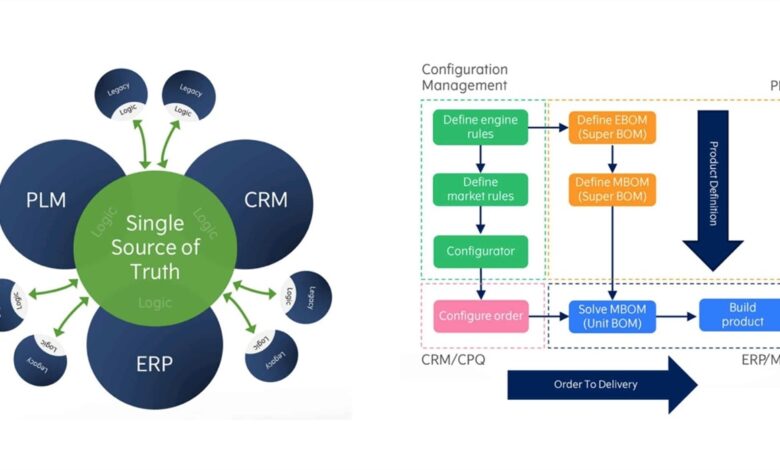The art and science of designing product features

Effective product feature management contributes to developing intuitive, value-driven functionalities that resonate with customers and consumers, fostering fit-for-purpose personalization and flawless change execution. (Image: Configit)
In a previous post, I discussed the evolution of product configuration management (CM) towards enterprise configuration (CM2) and how configuration lifecycle management (CLM) contributes to driving successful innovation and change traceability. I elaborated on the fact that “CLM sits at the intersection of CM, product lifecycle management (PLM), enterprise resource planning (ERP) and customer relationship management (CRM). It enables complex product modularity, centrally governing component alternatives and options across the portfolio. But it also facilitates cross-functional communication within and beyond the enterprise including engineering, manufacturing, sales, planning and services functions.”
Following this, I discussed with Henrik Hulgaard, co-founder and VP Product Management of Configit, sharing his perspectives on the “digital configuration thread” and expanding on the intersection of CM and CLM. From the outset, Hulgaard highlighted that, “although configuration management typically focuses on process excellence and change traceability, the word ‘configuration’ means something different.” He expanded on this by explaining that “configuration is about product features, how they are managed from a development and innovation perspective, how they are exposed to sales channels.”
Inspired by my conversation with Henrik Hulgaard, this post delves into the art and science of designing product features behind Configit’s approach to end-to-end configuration lifecycle management.
Hulgaard put forth a crucial premise: “while configuration intersects with traditional PLM, its essence lies in being product-oriented rather than project-oriented.” Traditional PLM predominantly revolves around managing part versions, adhering to design standards, and overseeing projects with defined timelines, resources, deliverables, and alterations. In contrast, a product-oriented approach shifts the spotlight onto the product itself—its features, functionalities, value proposition across its lifecycle, and its integration within the broader innovation portfolio.
Expounding on this notion, Hulgaard emphasized that “end-to-end CLM drives ideation from inception through new product development, introduction to sales channels, and all the way to component and product decommissioning.” Furthermore, he highlighted that “Engineer to Order (ETO) and Configure to Order (CTO) strategies heavily lean on carryover and common data approaches, necessitating flexibility and interchangeability to optimize reuse and minimize time to market.”
Three steps to fosters feature-driven innovation
Configit’s journey started over 20 years ago, developing their ACE configuration engine in close collaboration with Jaguar Land Rover from 2010 onwards. It brought CM to the next level, elevating CLM to new heights by introducing a comprehensive approach to achieve end-to-end configuration. As Hulgaard described in a Configit blog, the key to this lies in three fundamental steps:
Firstly, it emphasizes the importance of establishing a consistent language across the organization, enabled by a global feature dictionary. This ensures that standardized codes are used universally to describe product variants, fostering seamless communication and collaboration both internally and externally.
Secondly, it advocates for the separation of the physical representation of a product from its logical one. By defining a clear product model that abstracts from individual parts, organizations can analyze product variability effectively and optimize feature offerings. This model serves as a centralized hub that integrates input from various functional areas such as engineering, sales, manufacturing, and service, enabling a holistic understanding of product variants.
Lastly, it emphasizes the significance of robust system architecture to achieve alignment across different enterprise systems. By integrating PLM, CRM, and ERP systems and ensuring they share a common source of truth regarding configuration, organizations can streamline processes and eliminate errors. This alignment is said to facilitate efficient change propagation, ensuring that modifications made in one system are reflected consistently across the entire ecosystem.
Overall, Configit’s approach to end-to-end configuration not only claims to enhance efficiency and accuracy, but also improve collaboration and agility across all aspects of the business.
Let’s dig into this 3-step approach in more detail.
Global Feature Dictionary: a Common Language
Such dictionary serves as a foundational element, ensuring that all stakeholders within and outside the organization speak the same language when describing product variants. Standardizing feature codes enables seamless communication and collaboration across different departments, suppliers, and even customers. This consistency eliminates ambiguity and confusion, streamlining processes from design to delivery.
In this context, Hulgaard elaborated on how “greater value can be derived from the feature catalogue when the product is expressed in terms of features and expert rules, improving searchability and reusability throughout.” He explained that “the abstraction of product features from individual parts allows for a more holistic view of product configurations, enabling organizations to identify commonalities and optimize offerings across diverse product lines.”
In turn, this is also about fostering a culture of clarity, traceability, and alignment, laying the groundwork for effective end-to-end configuration management.
Integration of Physical and Logical Models
By defining clear product models that abstract from specific parts, organizations can gain deeper insights into product variability and can optimize feature offerings accordingly. This separation facilitates effective communication and collaboration across different functional areas, such as engineering, sales, manufacturing, and service.
Each department contributes unique perspectives and requirements to the centralized product model, ensuring a comprehensive understanding of product configurations. This integrated approach enables organizations to analyze and adapt to market demands more effectively, driving innovation and competitiveness.
More specifically, Hulgaard pointed out that “modularity can be derived from a logical bill of features by applying the relevant features to the product using feature codes as part of product attributes and specifications, extending feature usage to bills of materials (BOMs), product costing, requirements, production lines, shop-floor machines, sales orders, service operations, etc.” Furthermore, he highlighted that “CLM is about exposing variability to the customer and ensuring that the product can be manufactured.” This approach emphasizes the importance of understanding customer needs and preferences to create products that meet or exceed expectations. By focusing on features, product engineers can prioritize development efforts, optimize resource allocation, and enhance the overall product experience.
Interestingly, feature-driven product engineering and Model-Based Systems Engineering (MBSE) share common goals in optimizing product development processes, but they approach them from different angles. MBSE emphasizes the use of models to represent complex systems and their interactions. Both models capture the system’s requirements, architecture, behavior, and constraints, allowing engineers to analyze, simulate, and validate the system’s design before physical implementation. While feature-driven product engineering and MBSE approach product development from different perspectives, they appear to be complementary.
Alignment through a Digital Configuration Thread
Feature-driven engineering provides a customer-centric approach to product design, ensuring that products meet market demands and deliver value to customers. Meanwhile, MBSE provides a systematic framework for designing, analyzing, and optimizing complex systems, helping engineers develop products that are reliable, efficient, and cost-effective. Integrating both approaches can result in more robust and innovative product development processes.
By integrating PLM, CRM, and ERP systems and establishing a common source of truth for configuration data, organizations can streamline processes and eliminate discrepancies. This alignment ensures consistent and accurate information across all functional areas, enabling seamless change propagation and decision-making. Like a digital product passport, the bill of features is to inform the rationale for design, including supply chain alternates and substitutes, impacts to serviceability and sustainability, etc.
As summarized in its blog, Configit promotes a single source of truth for product feature configuration: “The key to achieving alignment is to make sure that these systems share the same source of truth with respect to configuration. […] Placing all the rules in one system, and then integrating from these enterprise systems to a centralized configuration engine, is the key to an aligned view.” The idea is simple: by centralizing configuration logic and rules within a dedicated configuration management system, organizations can adapt to evolving market needs with agility and confidence.
![How Nitrogen Fixation in Corn – and other crops – is Possible with Envita [Product Demonstration] How Nitrogen Fixation in Corn – and other crops – is Possible with Envita [Product Demonstration]](https://europeantech.news/wp-content/uploads/2024/04/Envita_Logo_RGB_Colour-390x198.png)


